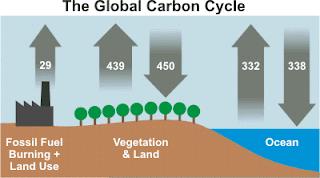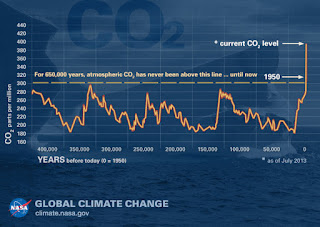Climate Geoengineering Part 2 of 4
This short series of posts addresses climate geoengineering: "the deliberate large-scale intervention in the Earth’s natural systems to counteract climate change." My aim is to answer the following questions:
This short series of posts addresses climate geoengineering: "the deliberate large-scale intervention in the Earth’s natural systems to counteract climate change." My aim is to answer the following questions:
- Prometheus or Icarus? - Why consider climate geoengineering at all?
- Fire and Ice - A synthetic sulphuric aerosol veil in the stratosphere?
- Obscured by Clouds - What other options are on the horizon?
- Kintsugi and the Moral Hazard - What would Jesus do?
This page on wikipedia does an awesome job laying out the ideas, methods, and issues with adding sulfur to the upper atmosphere to block some of the sun's energy from ever entering. In this post I've added a further background structure with the hope that the necessary details and logic are clear, straight-forward, informative, and worth the read.
This post is broken into 6 parts:
Before the industrial revolution, the global carbon cycle was well balanced for at least the past 800,000 years. In other words, any carbon added to the atmosphere through breathing or burning was soaked back up by either plant life or the ocean itself.
Carbon leaves the atmosphere in 2 main ways:
Sulfur is an essential element for life. It makes it into our upper atmosphere naturally from volcanoes erupting, and ocean plant life put some up there too. Since sulfur particles reflect some of the sunlight that hits them, particularly powerful volcanoes sometimes have a short-lived measurable cooling effect on Earth's climate. (Source.)
An industrial source of sulfur particles is the burning of fossil fuels, particularly coal. Because of the sulfur particles from coal power plants, it's actually possible that half of the warming due to CO2 in the atmosphere is actually being prevented due to our fossil fuel use. Whoa - so the Earth would actually be warming faster without the sulfur leaving smokestacks.
In fact, if we stopped using all fossil fuels tomorrow, we'd likely see a sharp upward spike in temperature in the near future because the sulfur we put into the sky with the CO2 wouldn't be there, but the CO2 still would be - sulfur particles fall down much sooner than the CO2 would (by at least 90 years), and more heat would be let in and then trapped. (Source.)
This is also why we saw a brief lull in temperature increases in the early 2000s; this lull is expected when we factor in China's growing industry's sulfur impacts on the atmosphere (Source).
Don't get me wrong, this isn't an endorsement to keep burning coal to keep out the some of the sun's energy. The CO2 we are putting into the atmosphere is way worse than the "cooling" benefit we get from the concomitant sulfur particles.
How we could get the sulfur up there:
This post is broken into 6 parts:
- The carbon cycle
- Where fossil fuels come from
- Where fossil fuel CO2 goes
- The greenhouse effect
- Atmospheric sulfur
- A veil to dim the sun
The Carbon Cycle
Before the industrial revolution, the global carbon cycle was well balanced for at least the past 800,000 years. In other words, any carbon added to the atmosphere through breathing or burning was soaked back up by either plant life or the ocean itself.
Carbon leaves the atmosphere in 2 main ways:
- Photosynthesis by plants. Plants breathe in carbon dioxide, take the carbon atom and fix it as carbohydrates (energy) or to their bodies as new plant matter. They then breathe out the leftover oxygen.
- Dissolving in sea water. Besides being used in photosynthesis by phytoplankton in the sunlit surface waters of the ocean, some ocean organisms use carbon to make their shells and skeletons or the carbon dioxide is stored as minerals through other chemical processes.
As the diagram above shows, the carbon dioxide put into the atmosphere by natural causes is balanced by the carbon dioxide that gets removed from the atmosphere by natural causes.
However, humans have been adding more CO2 to the atmosphere than Earth has been able to properly balance. The imbalance started with the industrial revolution. We'll be talking more about the imbalance briefly. (Source.)
When we burn fossil fuels, we're actually releasing the carbon dioxide that those plants breathed up and stored within their bodies and the bodies of the animals that ate them. Each time we burn fossil fuel we're releasing carbon that was stored deep underground for the last 300 million years or so. This added CO2 disrupts the natural balance that the carbon cycle has found over the last hundreds of thousands of years. (Source.)
However, humans have been adding more CO2 to the atmosphere than Earth has been able to properly balance. The imbalance started with the industrial revolution. We'll be talking more about the imbalance briefly. (Source.)
Where Fossil Fuels Come From
Well before dinosaurs walked on Earth, many plants and animals that died didn't decompose completely before getting trapped within a swamp (Earth was pretty swampy then). Eventually, the plant and animal life turned into the fossil fuels we use today.When we burn fossil fuels, we're actually releasing the carbon dioxide that those plants breathed up and stored within their bodies and the bodies of the animals that ate them. Each time we burn fossil fuel we're releasing carbon that was stored deep underground for the last 300 million years or so. This added CO2 disrupts the natural balance that the carbon cycle has found over the last hundreds of thousands of years. (Source.)
Where Fossil Fuel CO2 Goes
Land plants are capable of absorbing about 25% of the extra CO2 that humans add to the atmosphere. They actually kind of like that extra CO2; it makes them run more efficiently. Another 25% is absorbed by the oceans; this CO2 is mostly dissolved, and it makes the oceans more acidic (the oceans won't become an acid, but they move toward the acid side of the pH spectrum and it endangers crustaceans and coral). NOTE: the oceans are capable of absorbing less and less fossil fuel CO2.
The remaining 50% of fossil fuel CO2 stays in the atmosphere. We've increased the amount of atmospheric CO2 by about 43% since 1750. (Source.)
The Greenhouse Effect
"During the Middle Miocene, when temperatures were ~3° to 6°C warmer and sea level was 25 to 40 meters higher than at present, CO2 appears to have been similar to modern levels." - Science
If it weren't for the greenhouse effect, Earth might look something like this, a giant snowball of a planet:
Energy from the sun enters our atmosphere and heats up the surface of the planet a bit. Some of that heat gets radiated back into space, and some gets absorbed by greenhouse gases (like CO2) in our atmosphere. This absorbed heat is what gives Earth a habitable climate, but excess greenhouse gases are now giving us excess heat. Check out the image below. (Source.)
Here's a pretty common graph showing the relationship between temperature and atmospheric CO2 over the last 800,000 years (click to enlarge):
Atmospheric Sulfur
Some small molecules in our atmosphere absorb the sun's energy (like greenhouse gases). Others, such as small sulfur particles, reflect the sun's energy before it gets trapped in our atmosphere.Sulfur is an essential element for life. It makes it into our upper atmosphere naturally from volcanoes erupting, and ocean plant life put some up there too. Since sulfur particles reflect some of the sunlight that hits them, particularly powerful volcanoes sometimes have a short-lived measurable cooling effect on Earth's climate. (Source.)
An industrial source of sulfur particles is the burning of fossil fuels, particularly coal. Because of the sulfur particles from coal power plants, it's actually possible that half of the warming due to CO2 in the atmosphere is actually being prevented due to our fossil fuel use. Whoa - so the Earth would actually be warming faster without the sulfur leaving smokestacks.
In fact, if we stopped using all fossil fuels tomorrow, we'd likely see a sharp upward spike in temperature in the near future because the sulfur we put into the sky with the CO2 wouldn't be there, but the CO2 still would be - sulfur particles fall down much sooner than the CO2 would (by at least 90 years), and more heat would be let in and then trapped. (Source.)
This is also why we saw a brief lull in temperature increases in the early 2000s; this lull is expected when we factor in China's growing industry's sulfur impacts on the atmosphere (Source).
Don't get me wrong, this isn't an endorsement to keep burning coal to keep out the some of the sun's energy. The CO2 we are putting into the atmosphere is way worse than the "cooling" benefit we get from the concomitant sulfur particles.
A Veil to Dim the Sun
So, on to the main event. Basically, one of the leading ideas for dealing with the warming of the planet due to human-produced CO2 is to intentionally add sulfur molecules to the upper atmosphere. This "veil" in Earth's stratosphere would reflect some of the sun's energy before it entered Earth's atmosphere, thereby "cooling" Earth by preventing some of the sun's heat from getting to it in the first place.How we could get the sulfur up there:
- Airplanes, civilian and/or military.
- Modified artillery (large guns).
- High-altitude balloons.
Likely side-effects:
- Ozone depletion. The sulfur dioxide we put up there will interact with the ozone layer.
- Whitening or yellowing of the sky. The sulfur molecules won't just reflect the sun's light upward. It will reflect it in many directions, thereby altering the color of the sky. Side note: plants would prefer the light scattered, and sunsets would likely grow in beauty.
- Changing atmospheric circulation patterns. A temperature change in the upper atmosphere will likely occur, and this will cause changing circulation patterns in the upper atmosphere that will likely lead to new circulation patterns lower.
- Global weather patterns will shift. For example, the Asian monsoons alone, feeding hundreds of millions of people, would possibly dry up. (Source.)
Whilst such changes are very difficult to predict with high confidence, models suggest there will be both hydrological winners and losers. [Stratospheric veiling] could also have unpredictable and unexpected environmental effects; if so it could conceivably lead to climate changes that are worse than the 'no [veiling]' option.
Thank you for reading. A part of me still feels some deep sadness that we even have to explore geoengineering options, but we have to explore them, even if it's only to find out that the benefits won't outweigh the costs.
Part 3, coming soon...
Please comment if you have a response to this or any of my posts. I'd love to hear from you.
Please comment if you have a response to this or any of my posts. I'd love to hear from you.








No comments:
Post a Comment